Imagine a situation when your website hits a plateau despite your hard work.
You’ve written quality content. It’s optimized for the right keywords and has strong, relevant backlinks.
This common problem is often caused by neglecting a key SEO task – backlink management.
Backlink management is NOT the same as link building – but it’s also super important!
In this blog post, I’ll walk you through why backlink management matters and how it can significantly impact your website’s performance.
We’ll explore the do’s and don’ts, the tools that can help you make sense of it all, and the metrics you should be tracking.
Key Takeaways
- Backlink management involves monitoring, maintaining, and optimizing backlinks for better site rankings.
- The quality of backlinks (not the quantity) significantly impacts your website’s authority and search engine rankings.
- Active backlink management can help prevent penalties from search engines and protect your site’s SEO health.
- Tools like Google Search Console, Ahrefs, and SEMrush are invaluable for tracking and analyzing your backlink profile.
- Adding high-quality links from reputable sources diversifies your backlink profile. It makes your site more credible and visible.
- Regularly monitoring your backlinks allows for early detection and remediation of potentially harmful links.
- Neglecting backlink management can lead to an accumulation of low-quality links, which can hurt your site’s search rankings and reputation.
Understanding Backlinks: Back to Basics
Before discussing the importance of backlink management, we should first talk about why it’s essential to understand what backlinks are and how they work.
Backlinks are hyperlinks that point from one website to another. Most search engines view these links as votes of confidence or trust.
When good websites link to your site, it’s like a stamp of approval from the online community. This can greatly affect your website’s ranking and credibility.
In the SEO industry, you might see terms like “link juice” and “authority” passed around to talk about this transfer of trust or power.
However, not all backlinks are created equal. Search engines distinguish between high-quality backlinks and low-quality ones.
High-quality backlinks come from reputable websites with authority in your niche and contain relevant, informative content.
Note that this does not necessarily mean “high authority.” High authority links can still be low-quality!

Low-quality backlinks come from spammy or irrelevant sites and often have irrelevant anchor text. They can harm your website’s reputation and rankings.
Note that this does not mean “low authority.” Low authority links can still be high-quality!

Therefore, backlink management is crucial for maintaining a healthy backlink profile.
Why Is Backlink Management Important?
Backlink management isn’t only a technical task but an important component of your SEO efforts.
By watching and growing your backlink profile, you can try to protect your website from penalties. You can also raise your online visibility and get more organic traffic.
Here’s our explanation, based on our experience working with almost 2,000 clients at our link building agency, of why effective backlink management is important:
SEO Ranking Improvement
We believe that backlinks are one of the most influential factors in search engine algorithms.
And it’s not just us – if you search for “Google ranking factors,” you’ll most likely find backlinks near the top of every list you find, like this one.
Search engines like Google consider the number and quality of backlinks when determining how to rank websites in search results.
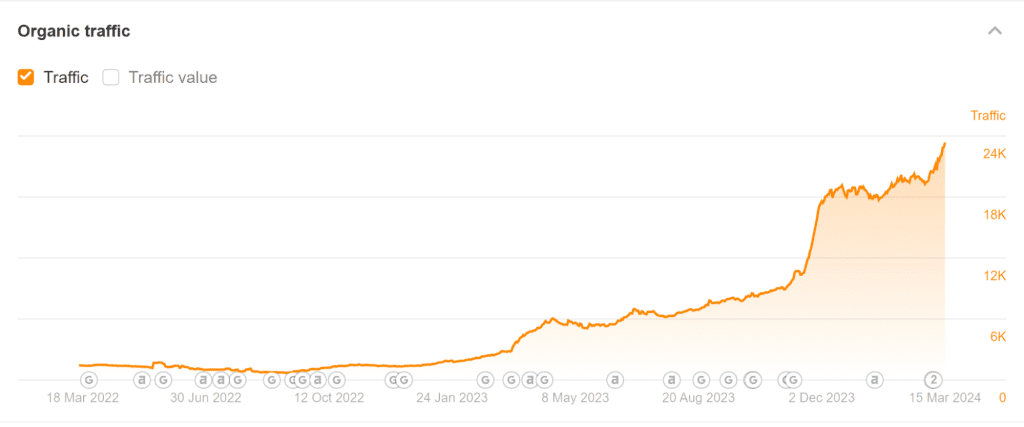
Manage your backlinks as we explain in this blog. This will ensure you have a strong and trusted backlink profile, which can improve your website’s rankings and visibility.
Credibility and Authority
I already mentioned that high-quality backlinks act as votes of confidence and trust from other websites.
When reputable and authoritative sites link to your content, it establishes your website as a credible source of information in your niche.
Managing your backlinks helps maintain your credibility and online authority.
Penalty Prevention
Search engines can penalize websites with unnatural or spammy backlink profiles.
This is not something we’ve seen as often in the past 5 years or so as Google tends to just ignore many links now.
But it does happen when Google wants to make a point!
(And sometimes to the occasional webmaster who claims they’ve never built a single link in their lives).
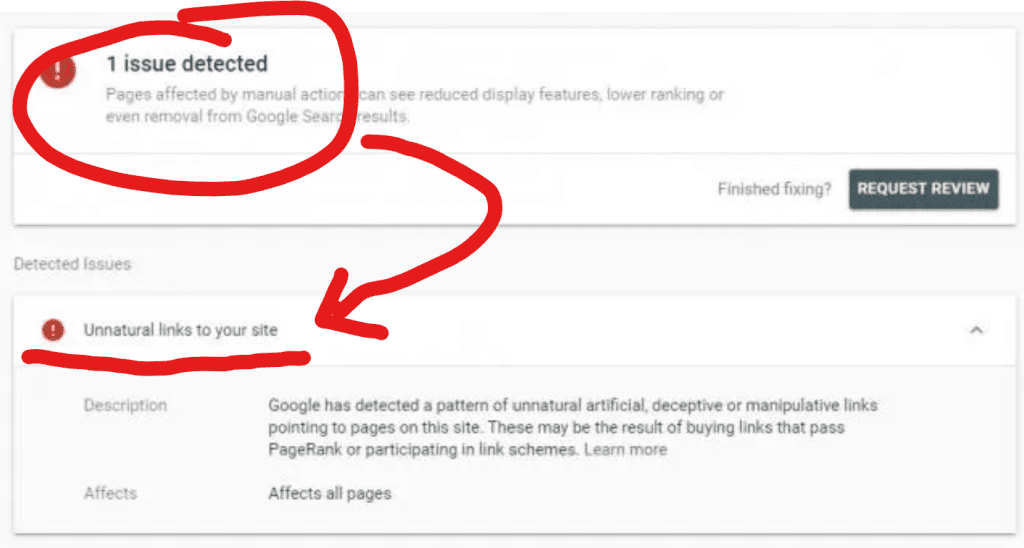
Effective backlink management includes monitoring the quality and relevance of your backlinks. It also often includes disavowing or removing low-quality ones.
This helps prevent your website from being penalized by search engines and protects your traffic and rankings.
Traffic and Exposure
Backlinks can drive direct traffic to your website (known as referral traffic).
When users click on a backlink from another site to yours, it’s an opportunity to showcase your content and products or services to a new audience.
Managing your backlinks ensures that you make the most of this traffic potential.
What Happens When You Don’t Manage Backlinks?
Neglecting backlink management can have severe consequences for your website’s traffic and rankings.
Here are some of the potential consequences of not actively managing your site’s backlinks, as reported by members of our Facebook group (SEO Round Table):
Low-Quality Backlinks Accumulate
Without proper management, low-quality or spammy backlinks can accumulate over time. These links may come from low-quality websites, link farms, or irrelevant sources.
Search engines like Google can penalize your website for having such unnatural or low-quality backlinks, leading to a drop in search engine rankings.
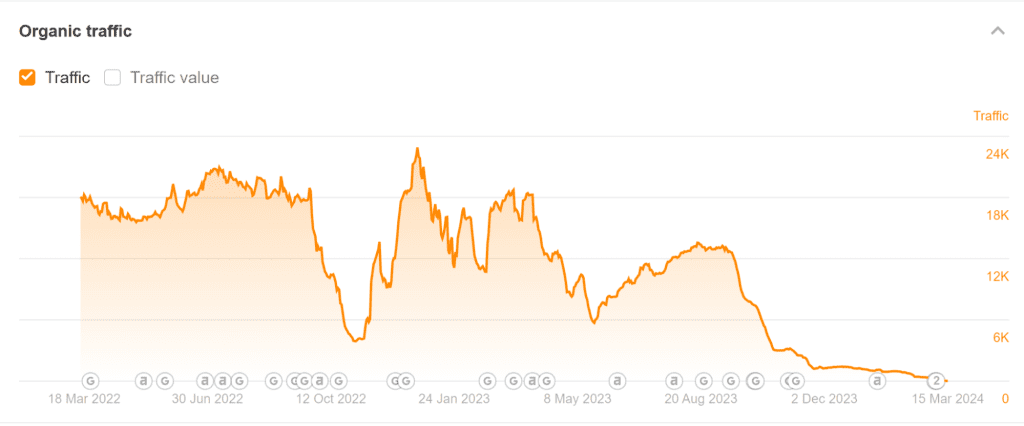
We believe that search engines have become smarter and will ignore the low-quality links, but the risk is always there.
Keep an eye on these types of links:
- Low-quality Blog comments
- Spammy Forum signature links
- Cheap PBNs
- Irrelevant directory submissions
- Article directories
- Links from hacked sites (SAPE)
- Irrelevant social bookmarks
- Low-quality press releases
- Spammy profile backlinks
A small quantity of these links will diversify your backlink profile, but you should never let them get out of hand.
Impact of Negative SEO
Search engines may perceive an unhealthy backlink profile created by people trying to hurt your site as your own attempt to manipulate search engine rankings.

This negative SEO attack did not hurt the site they were pointed to, but there’s always a chance.
This can lead to an accumulation of low-quality links and the consequences I described above. This can result in a significant drop in organic traffic and visibility.
Reputation Damage
Backlinks are, in part, a reflection of your website’s reputation.
If Google notices growth in the number of low-quality links to your pages, it can damage your credibility.
We have experienced negative SEO attacks when somebody targeted our site using a large quantity of low-quality links with adult anchors like those I have shown above.
Users might also question the reliability of your information, products, or services if they notice associations with untrustworthy sources of backlinks.
Inefficient Link Equity Distribution
Link equity, also known as link juice, is the SEO value that gets transferred from one website to another through backlinks.
Sometimes, we see how ineffective backlink management can result in a disbalance of link equity when a few of your pages have many backlinks, and most of the pages have none.
This isn’t always a bad thing as some content may go viral or gain popularity while your other pages don’t, but this can diminish the impact of high-quality backlinks on your rankings.
Difficulty in Diagnosing Issues
When you notice your site’s rankings are stagnating or even trending down, diagnosing the root cause can be challenging if you’re not actively managing your backlinks.
Without a well-maintained backlink profile, you may wonder if you need to address issues such as on-page problems, the presence of harmful links, and negative SEO attacks.

Regular monitoring and management can help you identify and address link-related issues promptly.
Monitor your backlink profile regularly, and you will be able to find irregularities, anomalies, or sudden changes in your backlink profile.
In my experience, early detection can be invaluable in preventing severe SEO setbacks.
We don’t normally do this ourselves, but I know many SEOs who keep very strict tabs on their backlinks and submit new disavow files monthly.
8 Best Practices for Backlink Management
We believe that managing backlinks is an ongoing process. It needs attention, planning, and a commitment to quality and relevance.
By following these best practices, you can protect and enhance your website’s rankings, authority, and online presence.
- Regular Monitoring
Backlinks should be monitored continuously.
We regularly check backlink profiles using tools like Google Search Console, Ahrefs, Moz, or SEMrush.
This helps to stay informed about the status of the backlinks, identify new ones, and detect changes in your existing ones.
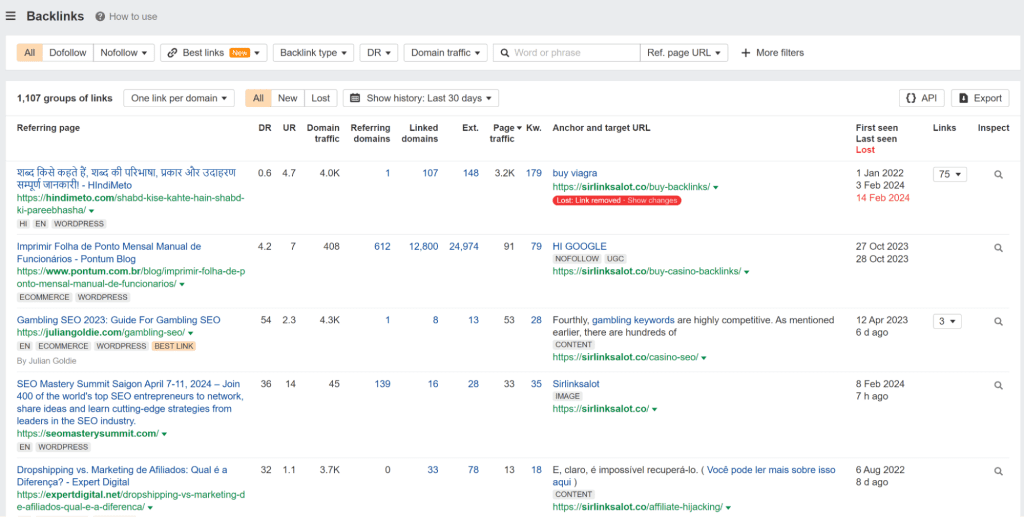
It’s better to be early than late!
- Quality Over Quantity
The saying “quality over quantity” holds especially true for backlinks.
Having a substantial number of backlinks can be appealing. It may be difficult to outrank your competitors if your site has a significantly lower number of referring domains.
For this reason, we get many questions on our live streams and in our Facebook Group about how many links you can safely build in a day, week, month, etc from people who are new to SEO and want to close the link gap with their competitors as fast as possible.
However, it’s the quality of these links that matters most.
We believe in prioritizing obtaining backlinks from authoritative, trustworthy websites in your industry through link-building campaigns. The relevance and the reputation of the linking site are very important.
- Disavowing Low-Quality Links
Not all backlinks are beneficial – some can be detrimental to your SEO efforts.
If you come across spammy or irrelevant backlinks in your profile, some experts suggest using Google’s Disavow Tool to inform search engines that you want these links to be disregarded.
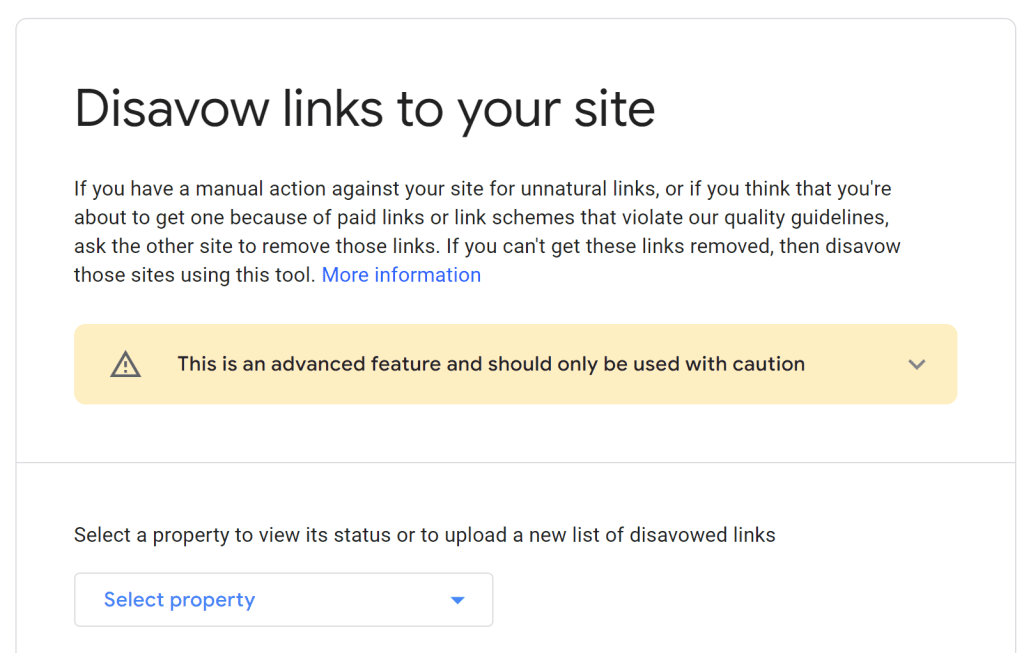
At SirLinksalot, we insist that disavowing is the absolute last resort when nothing else works, and you are certain that bad links are the cause of your site’s problems.
You may want to take Google’s statements with a grain of salt, but Google’s John Mueller seems to agree. He recently said that you won’t get your Google search rankings back by simply disavowing toxic links from a third-party report.
Disavow or not – that is something you have to decide, but again, we highly stress not disavowing any links yourself unless you are an expert.
This could be a very costly mistake!
- Guest Posting and Content Marketing
Develop a content marketing strategy that includes guest posting and link insertions on authoritative websites within your niche.
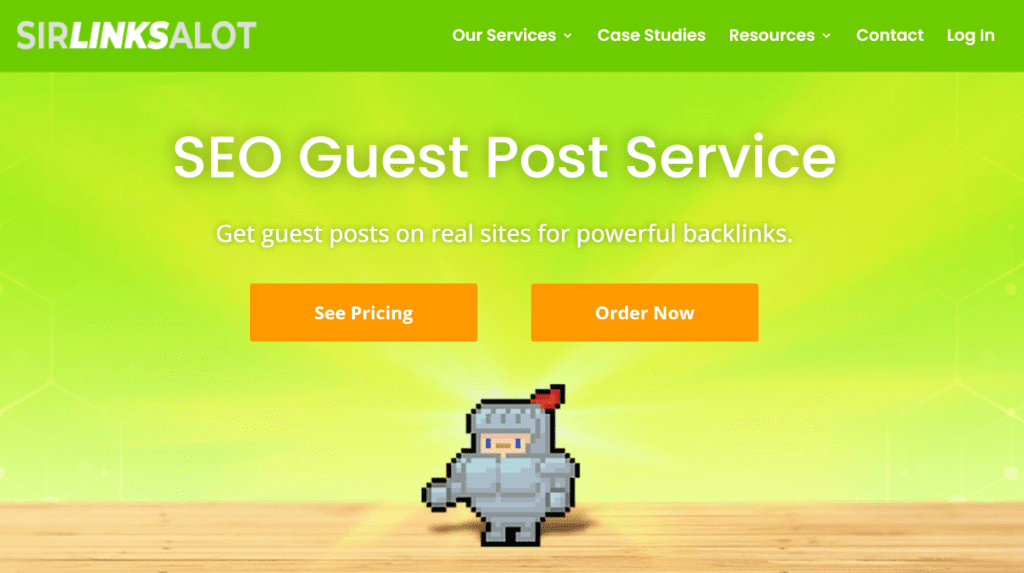
When you create content for other websites, ensure it is valuable and relevant to their audience.
Guest posting not only contributes to backlink acquisition but also fosters relationships in your industry.
These two types of backlinks are our most popular services for a reason – Google loves them!
- Relationship Building
Building real relationships with website owners, bloggers, and influencers in your niche can lead to organic backlink chances.
This is something we regularly do as a link building services provider.
Collaborations, content sharing, and mutual promotions often result from strong connections in your industry and can result in strong and relevant backlinks that are impossible to purchase.
Relationships matter – even if they only exist through email!
- Diversify Anchor Text
Anchor text diversity is essential for natural-looking backlinks.
As a refresher, anchor text is the visible, clickable text in a hyperlink.
In backlink management, a diverse range of anchor text is key. It helps create a balanced and effective backlink profile.
Avoid the pitfall of over-optimized anchor text with repetitive keywords – that is something we often see when we audit our clients under-performing sites.
Instead, use a variety of descriptive anchor text phrases that relate to the content being linked, as well as things like branded, URL, and generic anchors.
If you do have over-optimized anchor text already, you can just build new links with more natural anchors to fix the issue.
- Monitor Link Velocity
To maintain a natural backlink profile, monitor the rate at which you acquire new backlinks.
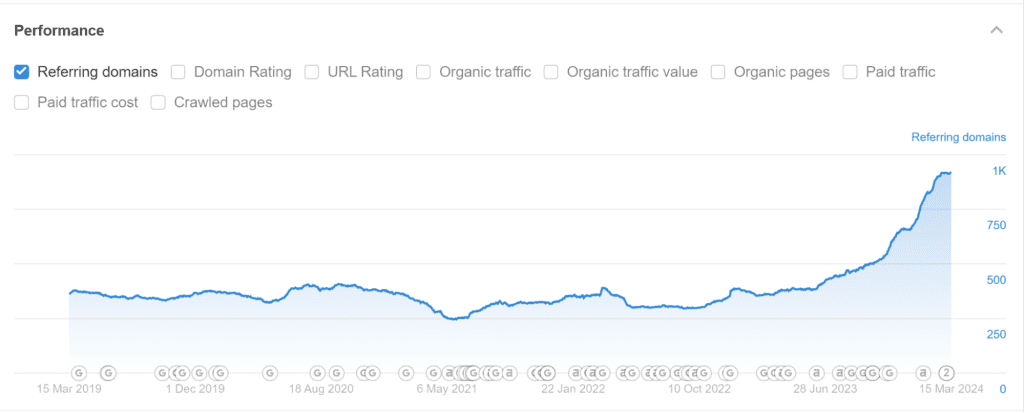
An excessive influx of backlinks in a short period can raise red flags with search engines. On the other hand, that naturally happens if your piece of content goes viral.
Aim for steady, gradual growth in your backlink profile.
What you really want to avoid is stopping link building completely. This will make Google think that your website was popular in the past but is no longer.
- Create Useful Content
Information is constantly evolving, so you need to regularly review and update your content to keep it fresh and relevant.
While praying for natural backlinks to appear is not a productive link building strategy, useful and unique content is more likely to attract links.
Bonus points if you actively promote your newly updated content after working on it!
Top Tools and Resources for Backlink Management
When managing backlinks, it is essential to have the right tools and resources at your fingertips.
These resources not only help you track and evaluate your backlink profile but also simplify the process of managing your backlinks effectively.
Google Search Console
Google Search Console is a free tool provided by Google that offers insights into your website’s presence in Google’s search results.
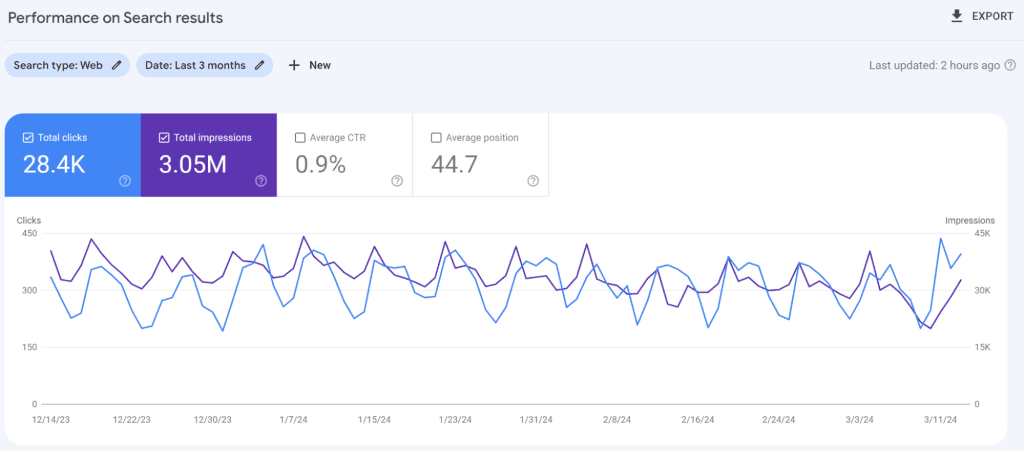
It provides valuable data on the backlinks pointing to your site, including which websites are linking to you and which pages they link to.
This information is essential for assessing the quality of your backlinks and addressing any problems.
That being said, we don’t use GSC very much for backlink management and much prefer 3rd party tools.
Third-party SEO Tools and Backlink Analysis Tools
Tools like Ahrefs, Moz, SEMrush, and Majestic provide in-depth insights into your backlink profile.
They offer metrics that help you assess the quality of your backlinks, identify opportunities for improvement, and track changes over time.
We mainly use Ahrefs, but you can also consider other tools that are in line with your needs and budget.
Tools like Monitor Backlinks, CognitiveSEO, and LinkResearchTools are designed to pinpoint problematic links that need disavowing or removal.
They help you identify low-quality or toxic backlinks that may be harming your SEO.
Some of these tools are expensive and have a steep learning curve, and their algorithms may or may not be able to pinpoint the toxic links.
Google Disavow Tool
Many SEO experts claim that the Google Disavow Tool is essential for dealing with low-quality or unwanted backlinks.
It allows you to submit a disavow file to Google, indicating which links you want to disassociate from your website.
As I said, for us it is a tool of last resort that we rarely use.
We much prefer to fix backlink issues by building new, quality links the right way rather than trying to get rid of old links that may be toxic.
Common Backlink Management Mistakes to Avoid
After listing the best practices that can help your site rank higher, it’s equally important to be aware of common mistakes that can do some harm.
Here are some key pitfalls to avoid:
Ignoring Backlinks
One of the gravest errors is neglecting your backlinks altogether.
Without continuous monitoring and management, you risk accumulating low-quality or toxic links that can harm your SEO.
Make backlink management a priority to protect your website’s integrity.
Even if an SEO agency or link building agency is building backlinks for you, it’s always good to keep a tab on things to ensure no issues arise.
Letting Low-Quality Backlinks Take Over
Low quality, spammy, or irrelevant backlinks can lead to poor results.
We do not believe in disavowing backlinks. Asking the linking sites’ owners to remove links to your site alse rarely works.
What else can you do to neutralize low-quality links?
Build high-quality links!
Over-Optimized Anchor Text
Over-optimized anchor text, often with repetitive keywords, can raise a red flag with search engines.

It can be perceived as an attempt to manipulate rankings, potentially resulting in penalties.
We always suggest to diversify your anchor text to appear natural and relevant.
Some natural anchor text ideas:
- Branded
- URL (naked)
- Generic
- Long-tail
- Combination (brand + other words, etc)
It’s always better to be natural than aggressive!
Relying on Black Hat Techniques
Engaging in black-hat SEO practices, such as buying cheap links on Fiverr or participating in blatant large-scale link schemes, is a significant mistake.
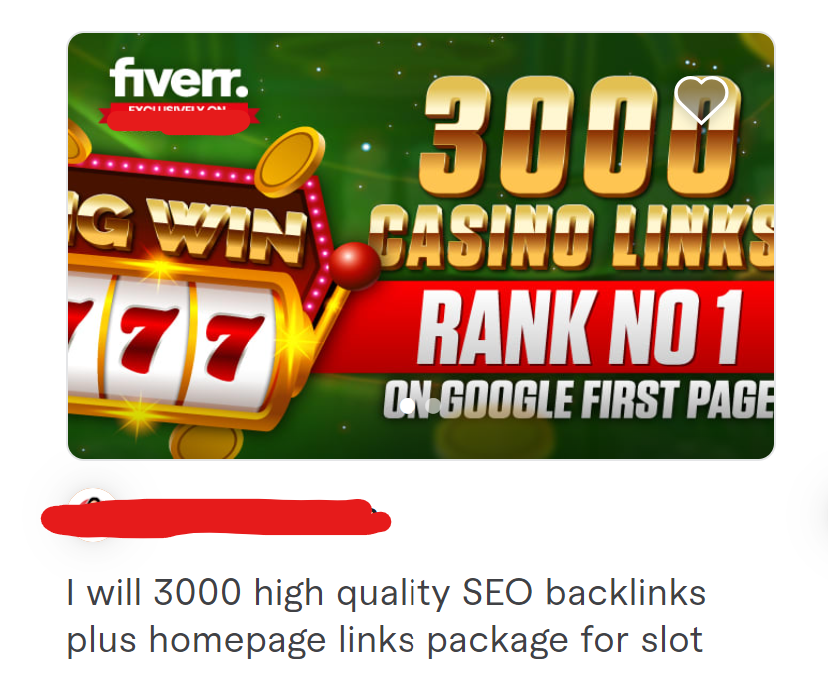
Sometimes, we notice that our clients bought cheap Fiverr backlinks before they started working with us.
The result? We have to do some extra work to minimize the damage these links can or have caused.
If we can easily see that they bought Fiverr links, don’t you think Google can too?
Search engines are becoming able to detect these tactics when done at scale, and the consequences can be damaging, ranging from ignoring these links to sitewide penalties.
Poorly Executed Link Building
While link building is a crucial part of SEO, we often see how haphazard or poorly executed efforts result in low-quality backlinks that harm your rankings.
Focus on ethical and sustainable link-building strategies to acquire valuable, relevant links.
Important Backlink Metrics You Need to Track
By tracking the backlink metrics I will discuss below, you can gain a comprehensive understanding of your backlink profile’s health and effectiveness.
This data enables you to make informed decisions to improve your website’s SEO and online authority.
But also note that metrics are only the beginning of a story. You have to take them in context with everything else to be able to make educated decisions for your SEO.
Number of Backlinks
The total number of backlinks pointing to your website.
While there is no fixed “good number” of backlinks, it’s generally a positive sign if you have a growing number of backlinks over time.
Number of Referring Domains
The number of unique domains linking to your site.

We believe this is a more meaningful metric than the number of backlinks.
Why would Google care if the same website endorsed your content a million times? That would make it way to easy to manipulate their search engine.
More diverse referring domains mean a stronger backlink profile with more authority and power.
Backlink Quality (DR or DA)
Focus on high-authority, trustworthy websites within your niche.
Metrics like Moz’s Domain Authority (DA) and Ahrefs’ Domain Rating (DR) (which we use when building links to our clients’ sites) are useful for assessing backlink quality.
We much prefer Ahrefs DR as it’s harder to manipulate and they have more backlink data.
DA and DR scores of 30 to 40 are typically considered average, while 50 or higher is often viewed as good. Scores above 60 are excellent.
However, remember that low authority scores don’t mean the links are bad. They can still be relevant, just not quite as powerful, and that’s just fine.
You can find these scores using tools like Moz’s Free Domain Authority Checker, Ahrefs’s Website Authority Checker, or other reputable SEO software.
Link Placement
As for link placement, it’s important to track where on the linking page your backlink is located.
In our experience, links within the main content area typically hold more weight than those in sidebars or footers.
That is why we focus on building contextual links that push more power to the target page.
Link Status
Regularly check the status of your backlinks. Ensure that they are alive, as permanently broken links on pages with 404 or 410 status will cause the link to stop transferring power over time.
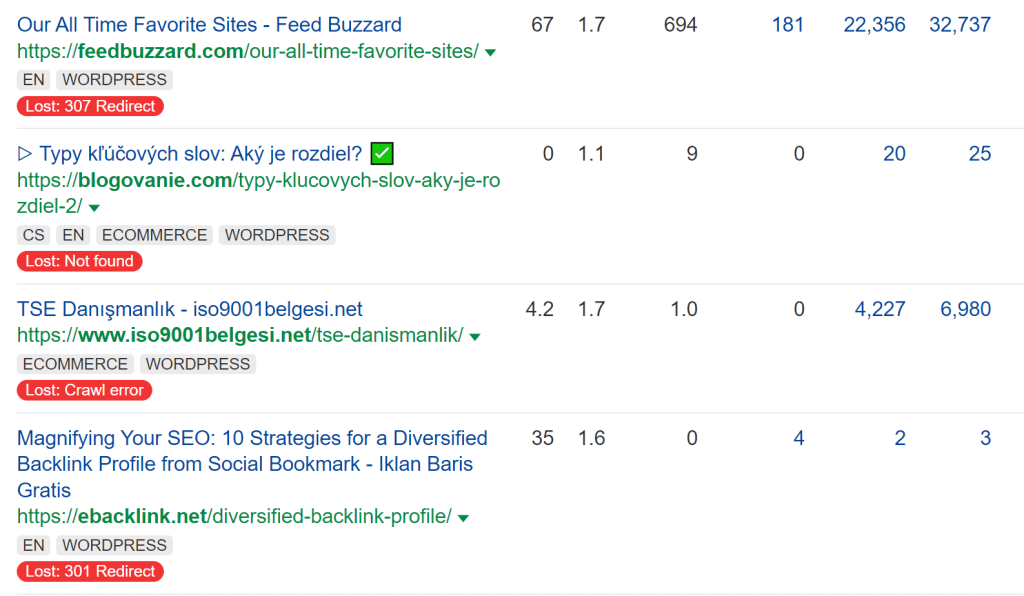
If you discover any issues, reach out to the linking website to suggest a fix for their site or replace the link.
But let’s be real – that is not likely to happen, and your best bet is building new links.
Still, it’s good to know if links are lost so that you can figure out your next steps.
Link Authority and Trust
Analyze the authority and trustworthiness of the websites linking to you.
We believe that backlinks from .edu or .gov domains, for example, may carry more weight.
But that doesn’t mean to go and spam .edu and .gov links! This can be highly unnatural.
Link Penalties
Monitor for any penalties imposed by search engines due to unnatural or spammy backlinks.
Address these issues promptly to maintain your website’s SEO health.
You can find any penalties in your GSC (Google Search Console).
NoFollow Links vs. DoFollow Links
A quick reminder about nofollow and dofollow links.
Nofollow links are a type of hyperlink attribute that instruct search engines not to pass any authority or “link juice” from the linking page to the linked page.
In other words, they are a way of suggesting search engines ignore this link when assessing the linked page’s authority.
It is important to keep in mind that this is only a suggestion, and the search engine may still pass the link juice through the nofollow link.
Some of our fellow SEOs are ranking sites using only nofollow links.
Conversely, dofollow links are the standard, default state of links. When a link doesn’t have the nofollow attribute, it’s considered a dofollow link.
These links pass authority from the linking page to the linked page. They’re an endorsement, signaling to search engines that the linked content is valuable and relevant.
At SirLinksalot, we focus on building dofollow links (with rare exceptions like pillow links or social signals), but we believe that a healthy backlinks profile should include both types of links.
Final Thoughts
Mastering backlink management can seem overwhelming and complex. Yet, it’s a critical component for maintaining the health and visibility of our websites.
And the more you do this task yourself, the easier it gets… like checking your bank account.
This article on backlink management has not only highlighted its importance but also provided actionable insights for effectively addressing its challenges.
Ignoring backlink management, however, can lead to bad effects like the accumulation of low-quality links and damage to your site’s rankings.
Backlink management demands the webmaster’s continuous attention, planning, and effort, which includes doing regular backlink audits.
So don’t skimp out on it. Hopefully, this helps!

